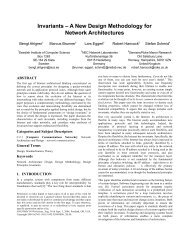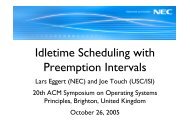Disruption Tolerant Networking - Lars Eggert
Disruption Tolerant Networking - Lars Eggert
Disruption Tolerant Networking - Lars Eggert
You also want an ePaper? Increase the reach of your titles
YUMPU automatically turns print PDFs into web optimized ePapers that Google loves.
deploy due to the inability to obtain network credentials on demand. Although there is<br />
interest in identity-based cryptosystems, this is nascent and the experience with such<br />
systems is fairly limited.<br />
In systems with mixed traffic (i.e., that may include asynchronous traffic along<br />
with quasi-synchronous traffic), some facility for indicating the quality-of-service<br />
requirements associated with the data may be important. The issue of signaling for<br />
this purpose (and possibly others) remains largely unexplored. It was noted that the<br />
general problem of signaling has gone in and out of IETF over the years (partly in the<br />
form of middle-box communication), but that it still remains out of standardization.<br />
In summary, this Dagstuhl seminar has sharpened the understanding of the very<br />
different perspectives from which researchers approach the problem space of disruption-tolerant<br />
networking, their assumptions and requirements, and the short- and longterm<br />
solutions they envision. This has broadened the view on DTN at large and contributes<br />
further issues to the present DTN research topics such as naming, security,<br />
service differentiation and efficiency. Assuming the traditional well-connected Internet<br />
architecture and its (interactive) applications as one extreme and the DTNRG<br />
architecture for purely asynchronous communications as another, the middle ground<br />
of mobile and partly (dis)connected operation may be approached from either edge.<br />
Future research will need to determine how far the DTNRG architecture can and<br />
should reach towards traditional Internet applications while maintaining its architectural<br />
integrity.





